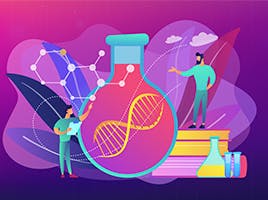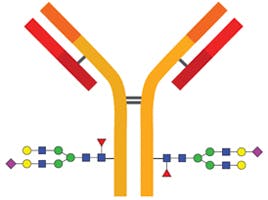
27 Feb 2020
Increasing reproducibility in biomolecule charge variant analysis
Biotherapeutic proteins are more difficult to manufacture than small molecules due to their heterogenous nature. They exist as a mixture of variants of structurally similar molecules.1 Such heterogeneity must be characterised during therapeutic production. One way the heterogeneity of mAbs can be revealed is ion exchange chromatography (IEX), which can separate proteins based on their overall charge. It is important to be able to detect and control such variants since changes in the overall charge profile can impact structure, stability, binding affinity, and efficacy.1 What is the basis of the ion exchange mechanism? And what are some sources of irreproducibility than may arise?
The principles of IEX
IEX remains one of the key technologies for charge variant analysis, separating biomolecules such as mAbs based on the difference in their net charge.1 Ion exchange chromatography (IEX) is a method to separate biomolecules, such as monoclonal antibodies (mAbs) based on the difference in net charge. Since different proteins are made up of various numbers and types of ionizable amino acid side chain groups they will generally have different overall net charges to each other at a given pH.2 The isoelectric point (pI) of a protein is the pH at which the overall charge on the protein is zero. Although the overall charge is zero at the pI the protein is not uncharged, it will have the same number of positively and negatively charged groups resulting in no overall charge.2 When a protein is in a buffered solution above its pI it will be negatively charged and bind to the positively charged functional groups on an anion exchange column. Alternatively, if a protein is below it’s pI it will be positively charged and bind to a cation exchange column. Since most proteins are only stable within a narrow pH range the choice of which ion exchange resin to use is often dependent on the pH stability of the protein, for mAbs this is most often a cation exchange resin.2,3
Some of the common post-translational modifications (PTMs) screened for using this mode of chromatography are asparagine deamidation and aspartate isomerization, with modification greater than 0.5% being able to be accurately measured. Other common PTMs which lend themselves to this type of analysis are C-terminal lysine truncation, methionine oxidation, N-terminal glutamine cyclization, succinimide formation, sialylation, glycation and C-terminal amidation. This type of analysis is useful for monoclonal antibodies (mAbs) where multiple variants with different PTMs may be present as low-level contaminants (Figure 1).4

Figure 1 Typical IEX chromatogram of a mAb sample
Column chemistries
Commercially available ion exchange columns are based on silica or polymer particles coated with a functional ion exchange group. Polymeric material is normally poly(styrene divinylbenzene) which has a hydrophilic coating to suppress secondary interactions. The use of polymeric particles is common for IEX since it offers greater pH stability and therefore improved column lifetimes, compared with silica materials which are much more restricted.3 Both porous and non-porous IEX particles are available. Whilst porous particles can provide an increased surface area and binding capacity, generally, for large biomolecules such as mAbs, non-porous particles are preferred to try and improve mass transfer and reduce band broadening.3
Ion exchange resins can contain a variety of functional moieties which confer different selectivity. Cation exchange resins are negatively charged whilst anion exchange resins are positively charged. IEX columns are categorized as “weak” or strong” exchangers. Some of the most common ion exchange functional groups are listed in Table 1.2,3 Rather than referring to the strength of ion binding, the terms “strong” and “weak” refer to the extent of the ionization of the functional group. Strong ion exchange materials contain functional groups which are charged over a wide pH range, whereas weak ion exchange materials comprise functional groups which lose their charge as the pH changes.2,3 Weak anion exchangers function poorly above pH 9 and weak cation exchangers begin to lose their ionization below pH 6. The number of charges on a strong ion exchanger remains constant regardless of the buffer pH. These phases retain their selectivity and capacity over a wide pH range.3

Table 1: summary of common ion exchange functional groups.
In terms of reproducibility, weak ion exchangers can be more variable than strong ion exchangers due to the variation in charge on the ion exchange functional groups. This can give rise to different retention times if the pH of the eluents changes slightly due to solvent or buffer evaporation. The resolution on WCX resins is also affected by sample loading and flow rate because intermediate forms of charge interaction will occur. If pH of the eluent does change, the weak ion exchange stationary phase needs more time to equilibrate, because functional groups need to be “titrated” to their new charged states, as a result, sample loading (binding capacity) is affected.
On the other hand, since functional groups on strong cation exchange (SCX) resins have the same charge over the whole pH range of the column, small differences in eluent pH will only change the charged state of the analytes, but not the stationary phase. In addition, you need less eluent/buffer for equilibration, which means better productivity and less buffer used. In addition, strong IEX materials also show less variation in binding capacity if you compare different proteins/peptides with each other.5 Given that SCX columns are inherently more robust to slight changes in a method, it makes sense that any additional variations in the manufacturing process could potentially give rise to much more variation in results from a WCX column compared with an SCX column.
Method development usually begins using strong ion exchange columns, allowing a wide range of pH values to be assessed. Since strong exchangers remain fully charged over a broad pH range it makes method optimization simpler than for weak exchanges. However, since weak exchangers can take up or lose protons with changes in buffer pH, they do provide a useful alternative selectivity for method development and can then be incorporated to provide different selectivity.2,3
Method considerations
Historically salt gradients are the “gold standard” for eluting proteins from IEX columns.1 The increasing concentrations of counterions compete for binding to the functional groups and elutes the protein from the column. The stronger the interaction of a protein with the column (i.e. the more charge it carries), the greater the salt concentration required to elute it.2,3 The high salt concentrations involved in elution using a salt gradient mean this method is not easily compatible with LC-MS. As LC-MS methods have become increasingly popular, using pH gradients for elution has also become commonplace. In pH gradient elution the pH varies with time, whilst the ionic strength remains constant. This works because changes in pH will affect the charge on the protein. At the pI of the protein it’s charge will be zero and it will elute from the column. In the case of weak ion exchangers pH can also provide additional selectivity since it will affect both the charge on the protein and the charge on the ion exchanger.2,3
Salt gradients generally provide improved resolution of similar structures, such as monoclonal antibodies (mAbs) that vary by a single lysine residue.1 Resolution is a function of the salt gradient, type of salt, temperature, column length and flow rate. Although pH gradients have the benefit of easy LC-MS compatibility, there remains debate about which method provides the best peak shape, capacities or resolution of the variants present.1,5 In a study of 10 intact mAbs a direct comparison ofpH and salt gradients showed generally the resolution is reduced. As can be seen for a range of therapeutic mAbs in figure 2.6 In terms of reproducibility, traditionally pH gradients have been difficult to create reproducibility and required complex buffer systems which resulted in inherent method variability. However, with modern quaternary pumps and automated buffer software, or commercial pre-made buffering systems the variability of pH methods should not be too different from a salt gradient method.

Figure 2 Generic pH and salt gradient method for the characterisation of 10 intact mAbs. Adapted from Fekete et al., J. Pharm. Biomed. Anal. 2015, 102, 33-34 & 282-289.5
Particle size selection
Analytical IEX columns come in a range of particle sizes, most commonly from sub-2µm to 10µm. As with other chromatography methods, decreasing particle size offers improvements in efficiency and resolution whilst reducing analysis time.3 However, at smaller particle sizes the increased system pressure and the possibility of frictional heating in the column can be problematic for biomolecules. This can cause reproducibility issues since biomolecules can be particularly sensitive to increased temperature or pressure and may degrade or aggregate. An alternative to increase sample throughput can be to use shorter columns at higher flow rates (Figure 3).3 When working with very particularly large biomolecules monolithic phases can be beneficial. Monolithic ion exchange phases contain continuous channels made of up of non-porous material which helps to improve mass transfer of slow diffusing biomolecules.3 These types of columns can support faster separation (high linear velocities) and improved resolution (due to faster mass transfer) whilst avoiding the high pressures associated with smaller particle columns.3

Figure 3: Protein separation on, WCX 3 μm column at 1 mL/min. flow rate (left), WCX 1.7 μm column at 1 mL/min. flow rate (middle), and WCX 1.7 μm column at 1.7 mL/min. flow rate (right). Increased flow rate and smaller particle size results in a reduced analysis time of 3 minutes without loss of peak shape and resolution.3
System considerations
Most column manufacturers now offer a range of columns specifically designed for the analysis of biomolecules, such as monoclonal antibodies, peptides and proteins, oligonucleotides, and polynucleotides. These columns are often constructed from PEEK instead of stainless steel.3 One problem that can lead to reproducibility problems is using an IEX column with a standard HPLC system rather than a dedicated bioinert system.7 Stainless steel components tend to corrode and form metal complexes (rust) when in contact with high salt/low pH eluents.7 These compounds may leach into the column and metal contamination may affect performance over time. In such cases, periodic passivation, according to the manufacturer’s instructions, is required to reduce rust build-up, although this can be a time-consuming process and using a dedicated bio-inert system is recommended when possible.7
Batch to batch variability problems
At Element, we recently heard from customers who are having issues with irreproducibility and batch to batch problems when using weak cation exchange (WCX) columns for charge variant analysis of monoclonal antibodies (mAbs). As mentioned, one option to increase reproducibility of your mAb charge variant analysis may be to move from a weak to a strong ion exchange column. Fekete et al evaluated various manufacturers columns with mAb samples and found that an SCX column performed very well in comparison to WCX alternatives.8 They found that whilst the Agilent Bio mAb NP 1.7 µm column (a WCX column) had the highest retention, the YMC BioPro SF[KB1] (an SCX column) had the lowest retention and yet the highest resolution for many of the mAbs tested. Indeed, an SCX column can often provide good resolution for antibody samples even compared with a WCX alternative (Figure 4).
Of course, it is not always possible to change a validated method and sometimes the alternative selectivity that a WCX column provides is required. If this is the case and you are experiencing batch to batch variation with your current column and have ruled out the sources of variability already mentioned in this article, then trying an alternative manufacturer may help. The robustness of the quality control procedures used during manufacturing the column will ultimately determine the variation in any column. Our technical team at Crawford are always on hand to offer advice on swapping to an SCX column or offer a recommendation for and equivalent WCX column from an alternative supplier.

Figure 4. Charge variant analysis using a weak and strong cation exchange analysis of humanised monoclonal IgG1. [Adapted from YMC Europe GMBH Biochromatography catalogue (2019)]
References
- http://www.chromatographyonline.com/advances-chromatography-charge-variant-profiling-biopharmaceuticals-0
- https://bitesizebio.com/31744/basics-ion-exchange-chromatography/
- https://www.chromacademy.com/lms/sco888/08-Column%20Selection-Biomolecule-Analysis-IEX.html?fChannel=27&fCourse=114&fSco=888&fPath=sco888/08-Column%20Selection-Biomolecule-Analysis-IEX.html
- https://www.chromacademy.com/lms/sco882/09-Ion-Exchange-Chromatography.html?fChannel=27&fCourse=114&fSco=882&fPath=sco882/09-Ion-Exchange-Chromatography.html
- Comparison of chromatographic ion-exchange resins V. Strong and weak cation exchange resins. Staby et al., J.Chrom A (2006)
- https://www.chromacademy.com/lms/sco888/06-Salt-Gradient-Elution-Conditions.html?fChannel=27&fCourse=114&fSco=888&fPath=sco888/06-Salt-Gradient-Elution-Conditions.html
- http://tools.thermofisher.com/content/sfs/brochures/109565-Flyer-ProPac-WCX10-Tips-Tricks-04Jan2011-LPN2717.pdf
- Characterization of cation exchanger stationary phases applied for the separation of therapeutic monoclonal antibodies. Fekete et al., J. Pharm Biomed Anal (2015)





